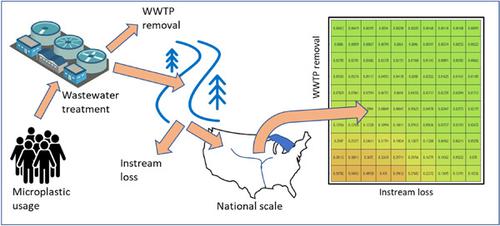当前位置:
X-MOL 学术
›
Environ. Toxicol. Chem.
›
论文详情
Our official English website, www.x-mol.net, welcomes your feedback! (Note: you will need to create a separate account there.)
A National-Scale Framework for Visualizing Riverine Concentrations of Microplastics Released from Municipal Wastewater Treatment Incorporating Generalized Instream Losses.
Environmental Toxicology and Chemistry ( IF 4.1 ) Pub Date : 2019-11-27 , DOI: 10.1002/etc.4610 Christopher M Holmes 1 , Scott D Dyer 1, 2 , Raghu Vamshi 1 , Nikki Maples-Reynolds 1 , Iain A Davies 3
Environmental Toxicology and Chemistry ( IF 4.1 ) Pub Date : 2019-11-27 , DOI: 10.1002/etc.4610 Christopher M Holmes 1 , Scott D Dyer 1, 2 , Raghu Vamshi 1 , Nikki Maples-Reynolds 1 , Iain A Davies 3
Affiliation

|
Down-the-drain exposure models provide a valuable tool for estimating environmental exposure to substances which are treated and discharged by municipal wastewater-treatment plants (WWTPs). Microplastics may enter WWTPs from consumer activities and disposal. An exposure framework was developed using the iSTREEM® model, which estimates spatially explicit concentrations of substances in riverine systems across the United States and portions of Ontario, Canada. One hundred simulations covering a range of WWTP removal and instream loss rates (proxy for net sedimentation) were incorporated into a Web-based visualization tool for user exploration of relative concentrations across simulations. Surface water concentrations specific to user-supplied tonnage were examined via interactive heat maps and cumulative distributions. Exploring the spatial aspect of iSTREEM results showed that modeling 90% WWTP removal and no instream loss resulted in 8.5% of the mass entering WWTPs discharged to marine estuaries (7.4%) or Great Lakes (1.1%) environments, with the remainder of the mass discharged (1.5%) in inland sinks or exiting the United States via rivers. Modeling an example instream loss of k = 0.1 d-1 (i.e., half-life = 7 d), terminal river segments contained 3.3% of influent mass (2.3% marine estuaries, 1.0% Great Lakes). Varying instream loss rates had substantial impacts on the total mass exported. The Web-based tool provided a user-based mechanism to visualize relative freshwater concentrations of microplastics across a large geographic area by varying simplified particle fate assumptions. Environ Toxicol Chem 2019;39:210-219. © 2019 SETAC.
中文翻译:

可视化从城市废水处理中释放的河水中的微塑料浓度的国家级框架,该框架包含了普遍的河川流失。
排水下泄模型为估算由市政废水处理厂(WWTP)处理和排放的物质的环境暴露提供了宝贵的工具。微塑料可能通过消费者的活动和处置进入污水处理厂。使用iSTREEM®模型开发了一种暴露框架,该模型估算了整个美国以及加拿大安大略省部分地区河流系统中物质的空间显式浓度。基于Web的可视化工具将涵盖一系列WWTP去除率和河道内流失率(用于净沉降的代理)的一百次模拟,供用户探索整个模拟中的相对浓度。通过交互式热图和累积分布检查了用户提供的吨位特定的地表水浓度。对iSTREEM结果的空间方面进行的探索表明,对90%的WWTP去除且没有溪流损失进行建模,结果导致有8.5%的污水进入排入海洋河口(7.4%)或大湖(1.1%)环境的污水处理厂,其余的全部通过内陆汇水或通过河流离开美国排放的水(1.5%)。以k = 0.1 d-1(即半衰期= 7 d)的入流损失为例,终端河段占进水量的3.3%(2.3%的海洋河口,1.0%的大湖)。河流损失率的变化对出口总量产生了重大影响。基于Web的工具提供了一种基于用户的机制,可通过更改简化的粒子命运假设来可视化整个较大地理区域中的微塑料的相对淡水浓度。Environ Toxicol Chem 2019; 39:210-219。©2019 SETAC。
更新日期:2019-12-27
中文翻译:

可视化从城市废水处理中释放的河水中的微塑料浓度的国家级框架,该框架包含了普遍的河川流失。
排水下泄模型为估算由市政废水处理厂(WWTP)处理和排放的物质的环境暴露提供了宝贵的工具。微塑料可能通过消费者的活动和处置进入污水处理厂。使用iSTREEM®模型开发了一种暴露框架,该模型估算了整个美国以及加拿大安大略省部分地区河流系统中物质的空间显式浓度。基于Web的可视化工具将涵盖一系列WWTP去除率和河道内流失率(用于净沉降的代理)的一百次模拟,供用户探索整个模拟中的相对浓度。通过交互式热图和累积分布检查了用户提供的吨位特定的地表水浓度。对iSTREEM结果的空间方面进行的探索表明,对90%的WWTP去除且没有溪流损失进行建模,结果导致有8.5%的污水进入排入海洋河口(7.4%)或大湖(1.1%)环境的污水处理厂,其余的全部通过内陆汇水或通过河流离开美国排放的水(1.5%)。以k = 0.1 d-1(即半衰期= 7 d)的入流损失为例,终端河段占进水量的3.3%(2.3%的海洋河口,1.0%的大湖)。河流损失率的变化对出口总量产生了重大影响。基于Web的工具提供了一种基于用户的机制,可通过更改简化的粒子命运假设来可视化整个较大地理区域中的微塑料的相对淡水浓度。Environ Toxicol Chem 2019; 39:210-219。©2019 SETAC。



























 京公网安备 11010802027423号
京公网安备 11010802027423号